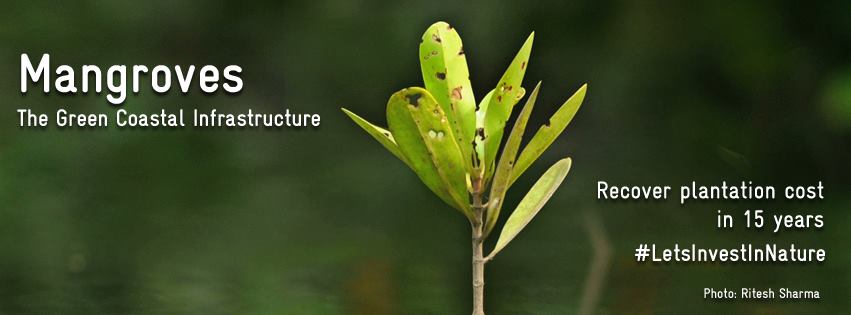Shubhangi Singh: India has a coastline of roughly 7516.6 Km across it’s 13 States and Union Territories. While India is racing towards being recognised as a global leader in the industrial and manufacturing sectors, the nation’s cities have been scaling up their urban quotient by rapidly building infrastructure to support this rising demand. In the quest for planning and making space for these infrastructural developments (through formal as well as informal modes) the country’s green cover is declining at an alarming rate. Increasing human population in coastal areas is resulting in increased pressure on mangrove ecosystems and given the large coastline India is gifted with, there comes with it the presence of mangroves that have proved themselves to be the silent sentinels of these coastlines. Unfortunately, regardless of their indispensability, these mangroves are fast being compromised for the sake of development.
But what if we were to build an infrastructure that boosts the economy, protects our lands from calamities and gives assured returns while still helping reduce global warming? Would that be possible?
Well, the answer could lie in simply preserving an existing asset we as a country are already bestowed with in the form of mangroves. Mangroves act as breeding and nursery grounds for commercial fisheries. With their dense and spongy roots, these mangroves are natural defence against storms and flooding. They also bind the soil together to check soil erosion. In addition to that, by being huge storage of carbon, mangroves significantly help reduce global warming. So, the mangroves actually provide a whole plethora of advantages ranging from food, fuel, recreation, contribution to fisheries, protection during disasters to aiding in climate control through carbon sequestration. Well, wouldn’t these be the exact reasons why we need to, not only, conserve our present mangroves but also find ways to increase them?
Take Gujarat for instance. With a massive plantation and restoration drive, the state of Gujarat has more than doubled its mangroves cover through reforestation and regeneration over mudflats. The planted mangroves have contributed to fisheries, to biodiversity and to other ecosystem services that depend on the mangroves for it’s survival. In Gujarat alone, through their contribution to commercial fisheries and soil amassment, these mangroves, now, provide benefits worth Rs 95.5 million annually. At this rate, the State’s investment in mangrove plantation and restoration would be recovered within approximately 15 years to further yield profits for the State. Given their future contribution to the economy, the mangroves should be looked at as long-term assets and not be evaluated just on the basis of their short-term gains. The effect on mangroves due to commercial fisheries and urban development and it’s subsequent crisis on the land as well as the environment must be carefully considered before allowing large chunks of the mangrove plantations to be wiped out. The consequence of reduced green cover that these mangroves naturally provide could have environmentally disastrous chain reaction.
Mangrove restoration is, certainly, a long-term ecological investment. Mangroves are the evergreen assets that should be treated as such and hence, urgent actions to not only conserve what we already have but to regenerate what we have lost is nothing short of essential as this stage. To invest in these assets, is to invest in the survival of ours and that of our future generations.

